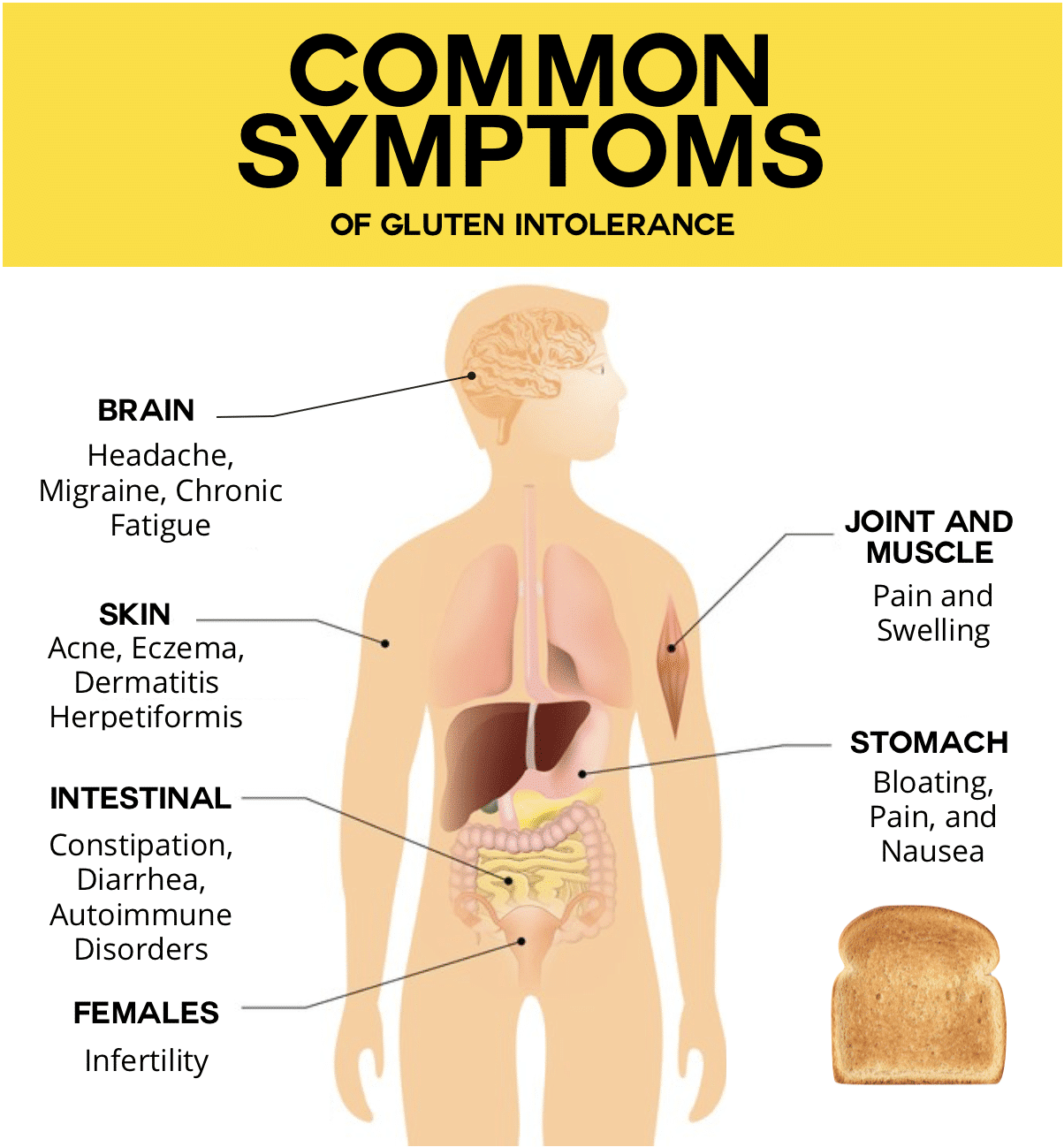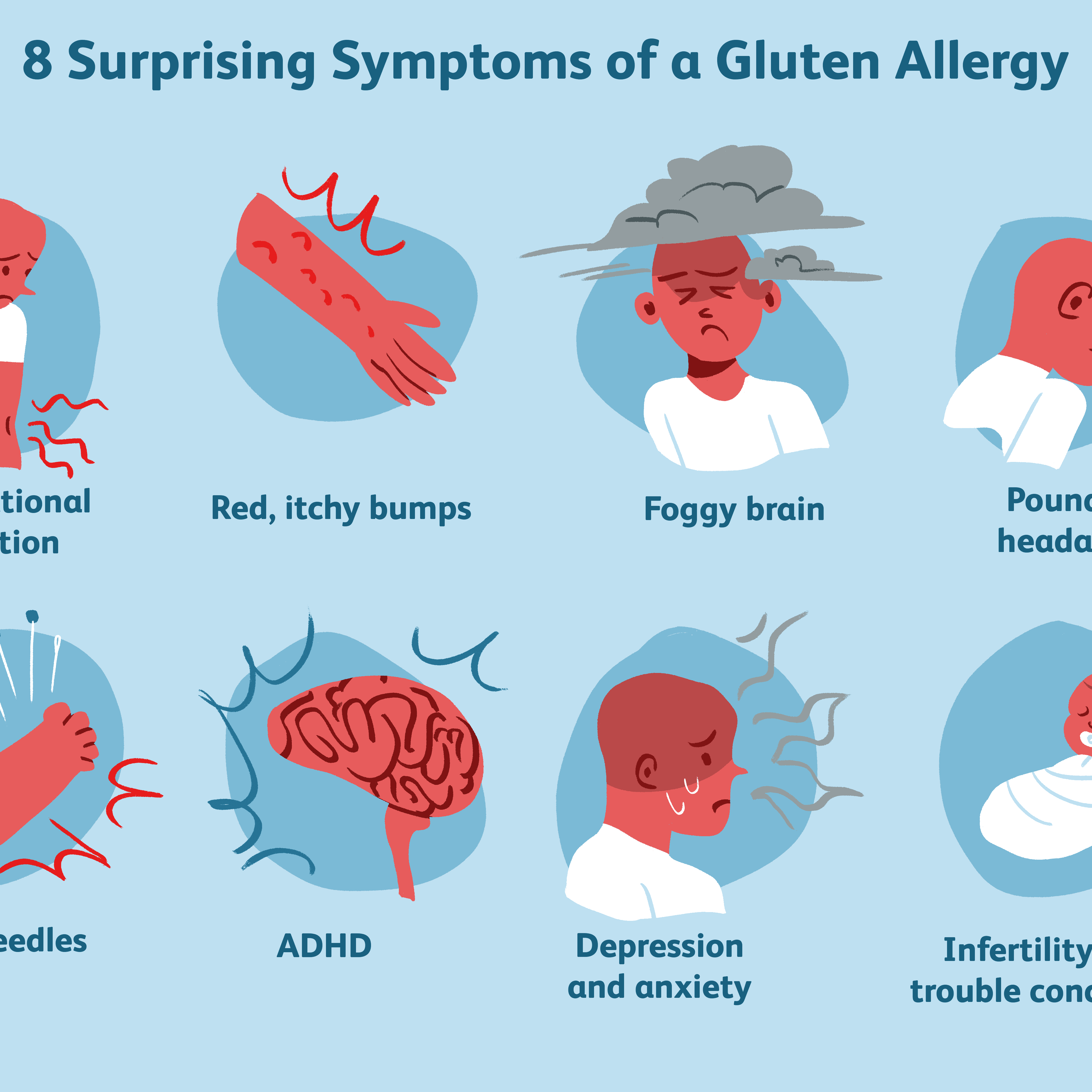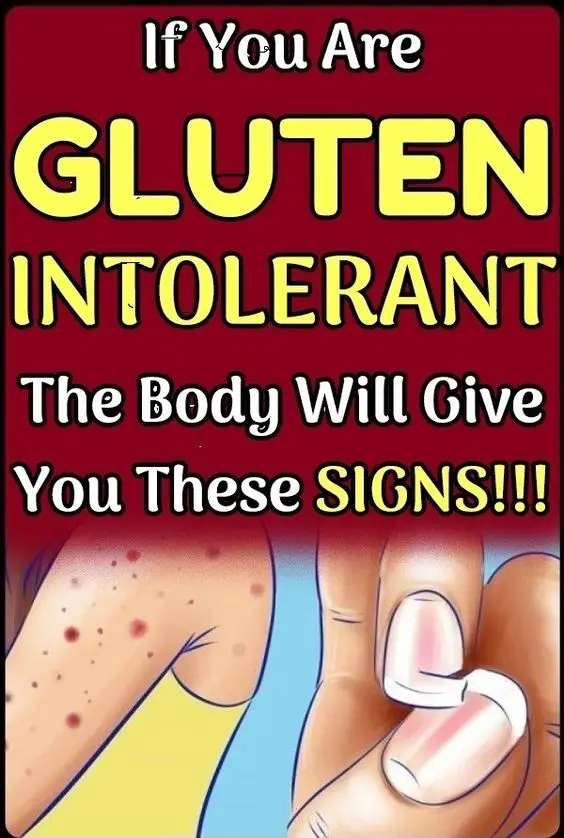Signs And Symptoms Of Gluten Intolerance
There is a huge fad component to the gluten-free movement.
However, many people genuinely cannot tolerate it, even if they dont have celiac disease.
The problem is they dont realise this, and then live with digestive symptoms as though its normal.
This article looks at the most common signs and symptoms of gluten intolerance.
Contents
Certain Seasonings And Condiments
The following seasonings and condiments are safe for those following gluten-free diets:
- apple cider vinegar
- fresh herbs like basil, rosemary, and cilantro
- pesto
Most sources of healthy fat, such as the following, are gluten-free.
- full fat yogurt
- unsweetened coconut
Summary
Foods that are safe to eat if you have a gluten intolerance include nuts, seeds, vegetables, fruits, fish, poultry, dairy products, gluten-free grains, and legumes.
Test To Tell If You’re Allergic To Gluten
Am I allergic to gluten? You ask. Well, there’re several tests for this. A gluten allergy is oftentimes difficult to diagnose. Many other conditions can create similar symptoms to gluten allergies, including celiac disease and gluten intolerance. Additionally, symptoms can vary in severity depending on the individual. The only way know for sure is to have yourself tested.
1. Elimination Diet
The first test used to ascertain whether someone has gluten allergies is with an elimination diet. With an elimination diet, people who suspect a gluten allergy removes foods that contain gluten, such as pasta, or wheat, from their diet for a length of time to determine if the symptoms are resolved. Unfortunately, an elimination diet will not completely rule out a gluten sensitivity, or celiac disease.
2. Blood/Skin Tests
A food allergy test such as a skin prick test, or pricking the skin with a needle or pin containing a small amount of the allergen can and do show gluten allergies. However, celiac/gluten intolerance is not an allergy, and the skin tests for allergies will not show it. There are blood tests for celiac/gluten intolerance, but there can still be some false negatives. Therefore, its usually followed up with stool antibody testing to see if you are throwing gluten antibodies into your stool.
3. IgE or Cell-Mediated Test
Don’t Miss: Mediterranean Diet And Gluten Free
Wheat Allergy In Adulthood
Although rare, WDEIA is a special form of wheat allergy that can progress to a very severe stage.
The strange thing about WDEIA is that adults and adolescents with this allergy can normally tolerate wheat. They only experience allergic reactions when they engage in physical activity after eating foods containing wheat. In addition to exercise, other triggers have been identified such as alcohol, medication, stress, or hormonal factors such as menstruation in the case of women. If one of these exacerbating factors coincides with wheat consumption, allergic reactions occur 30 minutes to six hours later. These can include itchy skin, wheals, hives or facial swelling. There may also be abdominal pain, diarrhoea or vomiting. In some cases, difficulty breathing, low blood pressure, heart palpitations and even circulatory collapse may occur.
Several Processed Foods And Other Items

Many processed foods and other popular items may also harbor gluten. These include:
- meat substitutes, such as veggie burgers and hot dogs
- prepared lunch meats
- canned soups and soup mixes
- puddings and instant dessert mixes
- certain ice creams
- french fries and other fried foods
- flavored tofu
Summary
Foods that contain gluten include breads, pastas, crackers, baked goods, many grains, and several beverages and processed items.
Though it may seem as if most foods are off-limits when youre intolerant to gluten, many delicious and healthy foods are naturally gluten-free. Plus, quality gluten-free breads, pastas, and crackers are available in most grocery stores.
If youre gluten intolerant, you can enjoy the following foods.
Read Also: Vegan And Gluten Free Desserts
Gluten Allergy Symptoms: Signs You Are Gluten Intolerant
Research suggests that gluten sensitivity impacts about six to seven percent of the population and that many people dont recognize gluten allergy symptoms. If you or someone you know is wondering about signs of gluten intolerance, read on.
Gluten is a protein that is found in wheat, barley, and rye. When someone is gluten intolerant, it means that the protein causes digestive problems, including gas, diarrhea, and abdominal pain. The symptoms of gluten allergy can be confused with other conditions though. For example, gluten allergy symptoms can be confused with Celiac disease. Celiac and gluten intolerance are not the same conditions.
Celiac disease is an inherited autoimmune disorder that can damage the small intestine. Gluten intolerance is an overreaction to a specific food that leads to uncomfortable symptoms. In the case of food allergies like gluten, some symptoms can be life-threatening.
Signs You Are Gluten Intolerant
While each case is a little different, there are some classic gluten intolerance symptoms. Having a full view of the signs of intolerance can help you when you sit down with a doctor to discuss any digestive problems you are having.
Also Read:
Avoid Foods That Contain Gluten
It is easier to identify some gluten-containing foods than others.
Foods that have a gluten-containing grain as one of their main ingredients may be easier to identify and avoid. For example:
- bread
So, if you have coeliac disease, you need to become ‘ingredient aware’. An Accredited Practising Dietitian can give you advice about how to follow a gluten-free diet.
to receive information and advice about following a gluten-free diet, including an ingredient list booklet which shows you which ingredients you need to avoid, as well as other benefits.
Don’t Miss: What Chocolate Is Gluten Free
How Is Coeliac Disease Diagnosed
As the symptoms of other conditions can closely mimic coeliac disease, it is important the diagnosis be confirmed to ensure appropriate treatment.
Your doctor will do special blood tests that measure certain antibodies for your initial screening. If the results are positive, your doctor will refer you to a gastroenterologist. This specialist will confirm the diagnosis by performing a gastroscopy a procedure that allows tiny samples to be taken from your small intestine. This procedure occurs while you are under sedation and involves a slender instrument being passed through your mouth into your small intestine.
Coeliac disease can be diagnosed without biopsy in some children if strict criteria are met. Importantly, a diagnosis of coeliac disease should only be made by a gastroenterologist.
Do not try to self-diagnose coeliac disease. If the blood tests and gastroscopy are to be accurate, its important that you do not put yourself on a gluten-free diet beforehand. These tests are dependent on a normal gluten intake.
Celiac Gluten Sensitivity Are Similar To Non
Remember, you may experience all the same symptoms but not have celiac disease. Gluten sensitivity and gluten intolerant people will not be able to confirm whether they have celiac disease without proper screening from the doctor.
It can be stressful to consider that you may have celiac disease. Symptoms of gluten intolerance or a wheat allergy, or celiac disease include the following and can vary from person to person. Common symptoms include:
- Bloating
- Anemia
You May Like: Where To Buy Gluten Free Empanada Dough
You’re Losing Weight Without Trying
Involuntary weight loss is one of the primary symptoms of celiac disease, because when your intestines are damaged you aren’t properly absorbing the food you eat, says Megan Patrick, M.D., a family medicine physician at UCHealth.
While NCGS doesn’t damage a person’s intestines, it can still lead to eating less due to associating so many foods with pain, which in turn can cause weight loss, says De Latour.
Symptoms And Causes Of Celiac Disease
People who have celiac disease commonly experience weight loss, as well as digestive symptoms, including diarrhea, abdominal pain, and bloating.
Some people notice mental and emotional symptoms, such as an inability to concentrate, commonly described as brain fog, or depression.
Not everyone with celiac disease experiences the same symptoms. Some people have no digestive complaints whatsoever, yet routine blood tests reveal low levels of vital nutrients, such as iron, vitamin B12, or vitamin D. NYU Langone doctors take all of these signs and symptoms into account when making a diagnosis.
The exact cause of celiac disease remains largely unknown. However, more than 99 percent of people with celiac disease test positive for two genetic variations known as HLADQ2 and HLADQ8. Not everyone who carries these variations develops celiac disease in fact, most people dont.
Some theories suggest environmental factors trigger celiac disease in people with these genetic variations, but more research is needed. Researchers have found that a family history of the disease increases a persons risk.
Also Check: Applegate Gluten Free Chicken Tenders
Symptoms Of Celiac Disease
Celiac disease is the most severe form of gluten intolerance.
It is an autoimmune disease that affects about 1% of the population and may lead to damage in the digestive system .
It can cause a wide range of symptoms, including skin problems, gastrointestinal issues, mood changes, and more.
Here are a few of the most common symptoms of celiac disease.
How Is Gluten Intolerance Diagnosed

Your healthcare provider carefully reviews your symptoms and medical history. If they suspect you have a gluten intolerance, these are the next steps to confirm the diagnosis:
- Step 1: You eat a diet containing gluten for about six weeks. During this time, your healthcare provider performs blood tests and skin tests to rule out a wheat allergy or celiac disease. There isnt a gluten intolerance test.
- Step 2: If you dont have a wheat allergy or celiac disease, your healthcare provider will ask you to exclude gluten from your diet for at least six weeks. Keep a thorough record of your symptoms during this time, noting which symptoms improve.
- Step 3: If your symptoms do improve while youre on a gluten-free diet, you gradually reintroduce gluten back into your diet. If symptoms return, you likely have a gluten intolerance.
You May Like: Gluten Free Gift Baskets With Wine
Common Symptoms Of Gluten Intolerance
Home > Blog > Diet and Nutrition | June 25, 2022
Over the last several years, gluten has received a lot of attention. Numerous gluten-free products have been introduced, and more and more people are embracing a gluten-free lifestyle. Gluten can cause problems in many people. Whether you have a gluten sensitivity or suffer from Celiac disease, gluten can cause a number of symptoms including gluten belly. Here we explore more about gluten and the most common symptoms of gluten intolerance.
Wheat Allergy In Childhood
Allergic reactions often appear a few minutes to hours after a food containing wheat is consumed for the first time. However, delayed symptoms can also occur for example, eczema can worsen one to two days after eating wheat. The overall prognosis for wheat allergy is positive. Like cows milk and egg allergies, it usually subsides by adolescence. The allergist can perform a test 12 to 18 months following diagnosis to check whether the allergy is still present so that children may resume wheat consumption as soon as possible.
Recommended Reading: Gluten Free Freeze Dried Backpacking Meals
The Signs And Symptoms Of Gluten Sensitivity
Chances are, you know someone on a gluten-free diet. Or maybe you know someone who can’t eat gluten, a protein combination found in cereal grains like wheat, rye and barley.
There are a few reasons for this recent interest in going gluten-free: About 1 percent of the United States population has celiac disease. When these people eat foods with gluten, it triggers an autoimmune response that damages the small intestine and can lead to long-term problems, like lymphoma and other autoimmune diseases like thyroid dysfunction, osteoporosis or osteopenia. But as much as 6 percent of the population may have a non-celiac gluten sensitivity . These people tend to feel better when they avoid gluten, even though they test negative for celiac disease.
Wondering if your child could be sensitive to gluten or benefit from a gluten-free diet? We asked Ritu Verma, MBChB, a pediatric gastroenterologist, Lustgarten Endowed Chair for Clinical Care of GI Motility Disorders, and director of CHOPs Center for Celiac Disease, for help in recognizing the signs of a gluten sensitivity. She also offers advice for what you should do if you think your child has a gluten sensitivity.
Gluten Gliadin And Glutenin
The two proteins that comprise gluten, gliadin and glutenin are found primarily in wheat, but the proteins are also present in other grains, such as rye and barley. Gluten sensitivity is simply intolerance that causes the body to have an abnormal response when it attempts to break down the proteins during the digestive process.
Don’t Miss: General Mills Gluten Free Cereal
Celiac Disease Vs Gluten Intolerance Vs Fructan Intolerance
First, its important to understand the difference between celiac disease and gluten intolerance.
Celiac disease is an autoimmune disease triggered by gluten.
Even tiny amounts of gluten will severely damage the small intestine of an individual with celiac disease.
On the other hand, gluten intolerance is thought to be a subtle sensitivity to gluten diagnosed after exclusion of celiac disease. Its said to affect between 0.5-13% of people .
In the scientific community its known as Non-Celiac Gluten Sensitivity or wheat sensitivity. Think of it much like you would an intolerance to FODMAPs.
In fact, newer research indicates that we may be incorrectly diagnosing a FODMAP intolerance as a gluten intolerance. Specifically, it really looks like what weve thought was gluten intolerance is actually a fructan intolerance .
A gluten intolerant individual can typically eat small amounts of gluten safely, but experiences health issues when their threshold is exceeded.
The following are common signs and symptoms of gluten intolerance, after celiac disease has been ruled out.
Summary: Gluten can physically damage the small intestine in those with celiac disease. A gluten intolerance, or Non-Celiac Gluten Sensitivity, is a more subtle sensitivity diagnosed after exclusion of celiac disease.
There Are Many Symptoms Of Gluten Intolerance And Celiac Disease
Most people wonder if they have celiac disease or a gluten intolerance because of gastrointestinal symptoms like gassiness, diarrhea, constipation or excessive bloating. But other symptoms might not be so obvious. And while gluten intolerance and celiac disease are different, many of the symptoms can be similar. Here are some signs of celiac disease and gluten intolerance you might not be aware of.
- Digestive issues
- Tingling or numbness in hands and/or feet
- Bone and joint pain
Also Check: Gluten Dairy Free Gift Baskets
How To Determine If Your Child Is Gluten Intolerant Or Has A Wheat Allergy
Once a blood test has confirmed that your child does not have celiac disease, the best way to determine a food sensitivityand specifically, a gluten intolerance or wheat allergyis to eliminate gluten from their diet and monitor how this affects their symptoms. Of course, this should always be done under the supervision of your childs doctor, and youll want to seek their medical advice in order to reach the right diagnosis.
Research Into Non Coeliac Gluten Sensitivity

Non coeliac gluten sensitivity is a condition that is being recognised as a problem in many countries across the world. This is a new area and we need more research to understand the condition and who is at risk. There are no specific diagnostic tests for non coeliac gluten sensitivity.
Some researchers define non coeliac gluten sensitivity as an improvement in symptoms when following a gluten free diet. However, it is difficult to rule out the possibility of a placebo effect.
There is also some debate around whether gluten is the cause of the sensitivity or if other components are to blame. These components are also removed from the diet when gluten containing ingredients are removed, for example Fermentable Oligo- Di- Mono-saccharides and Polyols and other non gluten proteins found in wheat.
Don’t Miss: Bob’s Red Mill Gluten Free Muesli
What Should I Do If Im Exposed To Gluten
Gluten is in countless foods, drinks and other products. Even if you stick to a gluten-free diet, you might accidentally eat gluten at some point. If you experience side effects from accidental gluten exposure, you can:
- Drink plenty of water to flush out your system.
- Eat small meals that arent spicy or fatty.
- Try ginger or peppermint tea to soothe an upset stomach.
Food Labelling And Gluten
All packaged foods have an ingredient list printed on the label.
Under mandatory labelling standards, all ingredients and food additives derived from wheat, rye, barley, or oats must be declared in the ingredient list of foods sold in Australia. The use of an allergen summary statement is also now mandatory gluten must be declared as Contains gluten, if present.
There is an Australian Food Standard for foods labelled ‘gluten free’. When these foods are tested, there must be ‘no detectable gluten’.
Read Also: Gluten Free Peanut Butter Granola Bars
Damage To The Small Intestine From Coeliac Disease
The normal lining of the small intestine is covered with tiny, finger-like projections called villi. The cells on villi break down and absorb nutrients in food. If you have coeliac disease, the mucosa of your small intestine is damaged. This causes inflammation of the villi, referred to as villous atrophy. As a result of this inflammation, the surface area of your small intestine, which enables the absorption of nutrients and minerals, is seriously reduced. This can lead to nutritional deficiencies.
What Causes Coeliac Disease
Coeliac disease is an autoimmune condition. This is where the immune system mistakenly attacks healthy tissue.
In coeliac disease, the immune system mistakes substances found inside gluten as a threat to the body and attacks them.
This damages the surface of the small bowel , disrupting the body’s ability to take in nutrients from food.
It’s not entirely clear what causes the immune system to act this way, but a combination of genetics and the environment appear to play a part.
Read Also: Best Restaurants With Gluten Free Options
